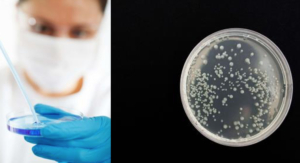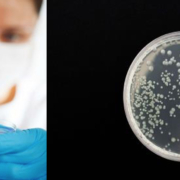ColonyStar accelerates colony counting with automatic counting mode

Regular colony counts are part of the day-to-day tasks of many laboratories in order to rule out the contamination of products with bacteria, viruses, yeasts, or moulds during production. To do this, Petri dishes containing the relevant samples are evaluated in order to determine the number of colonies formed. While the classic manual counting method means that every single colony has to be marked individually, automatic devices can analyse numerous Petri dishes of the same type very quickly. However, this requires time-consuming programming and preparation that may not be feasible if there is a small number of samples amounting to just a few Petri dishes a day.
The ColonyStar automatic from Funke-Gerber resolves this issue. The device, which is equipped with a camera and a cordless, detachable tablet, makes the analysis of Petri dishes both fast and straightforward. The unique assist mode is particularly helpful: After tapping on a colony via touchscreen, other colonies of the same type are automatically recorded, marked, and counted. The selection can be corrected at any time. In this way, the lab worker retains full control while also achieving huge time savings.
Total bacterial count
In hygiene management and quality control, the total bacterial count is one of the most important parameters. It states how many micro-organisms are contained within a sample. Depending on the type of micro-organism, there are limits that may not be exceeded in order to protect consumers from diseases such as food poisoning. As a result, samples are routinely cultured on Petri dishes in order to be able to determine the micro-organism concentration after a certain period via a colony count. Older devices in particular, however, that required the counting of every colony individually using a light table and microscope, made this task a time-consuming ordeal.
“A Petri dish like this, if it is processed at the right dilution, has between 150 and 200 colonies,” explains Konrad Schäfer, CEO of Funke-Dr. N. Gerber Labortechnik GmbH. “If they have to be counted manually, the person counting has to maintain their concentration and mark each colony individually. A routine task can quickly become a time-consuming endeavour.”
The previous method for colony counting also does not allow for the markings to be changed, which increases the risk of some colonies being counted twice. Automatic devices are more reliable but they are generally designed to handle larger batches and require a certain amount of effort to be invested beforehand.
“As a result of their complexity, such systems are a major financial investment. On the other hand, time-consuming preparations are necessary in order to program them because colony diameters or maximum/minimum contrast must be defined prior to automatic operation,” says Schäfer.
The ColonyStar automatic from Funke-Gerber, however, has been developed so that the device significantly accelerates manual counting with a semi-automatic counting mode. In order to mark 200 colonies, for example, only between four and 15 actions are necessary. The device operator retains complete control and does not have to rely solely on the device, as is the case with fully automatic solutions. In addition to this assist mode, the system can still be trained to identify selected colonies so that fully automatic colony counts can be conducted on predefined samples.
Additionally, the device features a fully automatic counting mode. The system can also be trained to recognize certain strains of bacteria and agar media. To do this, you can analyse ten to 15 Petri dishes containing the same species on the same agar media and then, after the learning phase, save it as a profile, such as Salmonella or yeast. Colonies of the same type that match these can then be analyzed fully automatically.
- For more information, visit: funke-gerber.de



